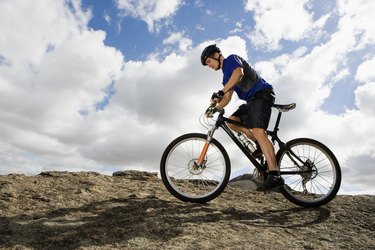
Bicycles come in a variety of sizes to match the heights, inseams and proportions of different riders. Most frames come in a wide variety of sizes, while others come in just small, medium and large. A mountain bike uses standard measurement for frame measurements, while road bikes use the metric system. Choosing a frame size requires a few simple measurements you can do yourself, but fine-tuning the fit of your bicycle is best handled by a certified professional.
No Bones About It
Video of the Day
The main measurement used to determine the size of a bicycle frame is known as your pubic bone height, which closely resembles your inseam. For a cyclist, this measurement extends from the base of your pubic bone, a hard spot between your legs, just behind your genitals. Measure from the pubic bone to the base of your heel down the inside of your leg. You'll need to be wearing the shoes you cycle with.
Video of the Day
A Match Made in Heaven
Once you have this measurement, you can compare it to a manufacturer's inseam measurement and determine which frame size is best suited to your frame. Mountain bike frames are measured in inches, and usually fall between 13 and 23 inches. Road bikes use the metric system, and usually fall between 48 and 63 centimeters. If your measurement falls between two sizes, it's usually better to size down so that you can make up the difference using your seat tube and handlebar stem.
Finishing the Fit
The correct frame size is only half the battle when you're getting fitted for a new bike. Matching the bike to your proportions requires a properly set seat height and the correct stem length, which correspond to your torso length and your inseam. Fitting a bike is part science and part art, and a professional bike shop usually has one or more employees with a bike fitting certification to fine-tune your bicycle's fit to your proportions. Having the bike fit professionally ensures your pedaling will be as efficient and pain-free as possible. However, you can get the sizing close yourself by making small adjustments between rides.
Gentlemen Need Not Apply
Women-specific bicycles have slightly different geometry to match the differences between male and female riders. These bikes feature longer seat tubes and shorter top tubes, because women often have longer legs in proportion to their torsos than men. The frame sizes are still measured based on pubic bone height, but these design cues provide a better fit for female riders for the most comfort. These bikes are also fitted with wider seats and narrower handlebars, making them uniquely suited to wider hips and narrower shoulders found on the majority of women.
- Rivendell Bicycle Works: Choosing a Frame Size
- BikeFit: How to Fit a Road Bicycle
- NYCEWheels: Bike Frame Sizes: How to Measure and Pick the Correct Size Bicycle
- REI: Fitting your Bicycle
- Team Estrogen: Guide to "Women Specific" Bicycles
- Midwest Women's Cycling Clinic
- REI: Commuter Bike Gear: How to Choose
- REI: Road Bikes: How to Choose